For decades, the US civil and military space communities have been bound together by their pursuit of space power. What is beneficial to one is beneficial to the other. More importantly, what is injurious to one is injurious to the other.
In the years between the world wars, civil and military aviation research and development programs produced a technology base to support civil and military aviation alike. In the same way, civil and military space research and development of the postwar years built the foundation for today’s US space dominance.
The question is, will America long continue to enjoy such supremacy
The answer is far from clear. Today, America’s civil space authorities can no longer say with any certainty that the United States will remain dominant in space, or even build many of its own launch vehicles. It is an extraordinary situation, one that would have been inconceivable to the many architects of American space power.
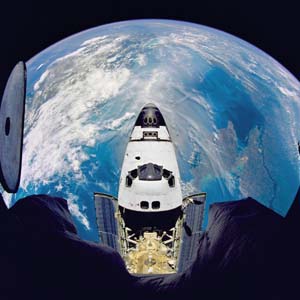 |
The space shuttle Atlantis, cargo bay doors open, orbits the Earth. The last shuttle mission is slated for next year. (NASA photo) |
After NASA retires its last space shuttle next year (and sets adrift thousands of skilled space workers), US astronauts will have to hitch rides on Russia’s Soyuz, paying $50 million apiece for the privilege, to get to a space station funded by the American taxpayer.
Those taxpayers might be forgiven for asking who really “won” the Kennedy-Johnson-Nixon-Khrushchev-Kosygin-Brezhnev-era space race.
The answer is that the space race is not over. When Neil Armstrong, Buzz Aldrin, and Michael Collins journeyed to the moon, planted a flag, and left footprints in its dust back in July 1969, they won that particular race. No scientific and technological triumph, however great, suffices for all time to ensure the national superiority or even security.
The Space Age began on Oct. 4, 1957, with the Soviet Union’s successful orbiting of Sputnik. Sputnik was a stunningly transformative event. Defense officials immediately realized the security implications: A nation that could orbit a satellite could strike another nation halfway around the world.
Lt. Gen. Donald L. Putt, the Air Force’s deputy chief of staff for development, warned, “We cannot permit the dominance of space by those who say they will bury the United States.”
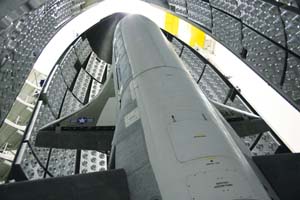 |
The X-37B Orbital Test Vehicle, shown at the Astrotech Corp. facility in Titusville, Fla. Officials hope this unmanned space vehicle will provide orbital reusable access, not unlike a fighter for space flight. ( Astrotech photo) |
The controversy precipitated a huge effort. Its result seemingly is well-established. The accepted narrative is that, in 1961, President Kennedy gave NASA the mission of putting a man on the moon within the decade. Guided by Wernher von Braun, the US filled space with satellites and ripped through Projects Mercury, Gemini, and Apollo, fulfilling Kennedy’s mandate. The US thus won the space race, and then opened the era of the space shuttle and the International Space Station.
As is the case with most simple narratives, this one isn’t really true. Reality was quite a bit more complex.
Kennedy may have focused national attention on “big” space and given America its moon goal, but it was President Eisenhower who really launched US space policy, particularly as applied to the national security needs of the United States.
As general and President, Ike was a strong supporter of airpower and an early advocate of an independent Air Force. That attitude carried over into his handling of space—in particular, space-based reconnaissance. He presided over the Aug. 25, 1960, establishment of the National Reconnaissance Office.
In the view of space historian R. Cargill Hall, Eisenhower “framed the US space policy edifice. His successors either embraced the Eisenhower design or, at most, refined it by adding a window here and a door there.”
Ambitions Von Braun, the charismatic German-American engineer and rocket scientist, became the symbol of American space leadership. However, the US did much more than simply follow him through a series of ever more-complex and technologically demanding big space projects. More important, probably, was the careful, incremental approach of Air Force Gen. Bernard A. Schriever, who set to work in 1953 on an ICBM in response to a call by Trevor Gardner, special assistant for Air Force research and development. Together, Schriever and Gardner built America’s practical military and civil space power.
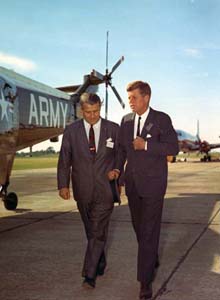 |
Wernher von Braun (l) speaks with President Kennedy in May 1963. ( NASA photo) |
Von Braun’s launch vehicles vanished at the conclusion of programs they supported: Redstone with Project Mercury, Saturn with Project Apollo. However, Gardner and Schriever developed legendary ballistic missiles—Atlas, Thor, Titan—that formed the core of US national launch capabilities. Derivatives and descendants are still used today.
Schriever’s Atlas became operational in August 1960, and soon was a mainstay of civil and military spacelift. Success with Atlas and other programs contributed greatly to USAF’s being named lead service for military space development in 1961.
The Air Force was ambitious. Schriever had forecast “the coming of astro power,” and one space advocate predicted that, by the 1980s, the Air Force would have upward of 10,000 rated space-vehicle crew members routinely making spaceflights.
USAF was building on its vision of jet-and-rocket flight. Some proposed aircraft—the F-108 interceptor, the X-6 nuclear-powered airplane, the Aerospaceplane—were too fanciful or impractical. The Pentagon, however, abandoned two very promising projects: Dyna-Soar and the Manned Orbiting Laboratory (MOL). The former was an attempt to build a winged orbital boost-glider spacecraft, the latter an attempt at an early on-the-cheap military space station.
The Air Force-Boeing Dyna-Soar program offered USAF the potential flexibility and reusability of an airplane. Many today believe the program could have ushered in an era of small and extremely useful F-16-sized winged orbital spacecraft. However, Defense Secretary Robert S. McNamara decided to cancel it.
Recent development of the unmanned X-37B Orbital Test Vehicle, first flown in April 2010, is a similar effort to make space-access vehicles more like aircraft. The goal is fighter-like reusability—nearly a half-century after Dyna-Soar’s demise.
The MOL program attempted to exploit the two-man Gemini spacecraft for military purposes, using proven Titan III launcher systems. MOL was hamstrung by the cost of the Vietnam War and Great Society social programs. Funding cuts brought delay. With the development of more-reliable unmanned satellite systems, MOL eventually ran out of support and was canceled in 1969.
Dyna-Soar and MOL were only two efforts. There also were plans to use tailored hypersonic re-entry shapes, known as lifting bodies, as possible manned spacecraft.
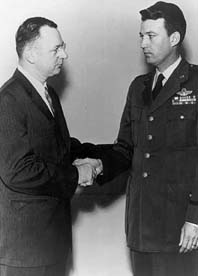 |
Maj. Gen. Bernard Schriever (r) and USAF assistant secretary for R&D Trevor Gardner (l) worked together to build US space power. ( USAF photo) |
One of these, the Martin SV-5 shape, was flown as a small re-entry test bed; it re-entered the atmosphere at Mach 27 and maneuvered to an area in the Pacific near Kwajalein atoll. Tests in a low-speed, piloted variant, the X-24A, proved an astronaut could control such a craft and bring it to a precise landing. However, there was never a piloted flight of an SV-5.
Fortunately, many other Air Force space projects of the ’60s did go forward, building long-lasting and transformative space capabilities. Most were undertaken with other agencies. These included the Corona reconnaissance satellite, which ushered in the era of space-based orbital observation; the MIDAS (Missile Defense Alarm System) missile detection satellite; the Spacetrack satellite and debris tracking system; the Vela Hotel nuclear detection satellite system; and various communication, meteorological, and navigation satellites.
However, the US had missed a big chance. Dyna-Soar, the MOL program, the Gemini spacecraft, and various lifting body programs gave the US a unique opportunity to advance in space. Washington failed to take advantage of any of them.
After McNamara canceled Dyna-Soar, America still had an opportunity to achieve routine human access to space and exploit the potential of low Earth orbit, using Titan-launched Gemini and a small orbiting facility. Instead, successive Administrations abandoned such pioneering achievable systems and went for more immediate big space projects.
Gemini ended, to be followed by Apollo, the less-than-satisfactory Skylab project, the space shuttle, the International Space Station, and the abortive National Aerospace Plane.
Given the massive costs of the Great Society and Vietnam War, it was probably inevitable that heavy civilian space outlays would end. After Vietnam, the services had to restructure and re-equip their conventional forces, which also served to put the squeeze on space spending.
Still, USAF’s space element continued to mature. The Air Force developed systems such as the Defense Support Program infrared reconnaissance satellite, Defense Satellite Communications System, Defense Meteorological Satellite Program, and Global Positioning System navigation constellation.
During this period, Air Force activities greatly benefitted civilian space science. Vela satellites contributed to X-ray and Gamma-ray astronomy. Reconnaissance satellites influenced the design and capabilities of Hubble Space Telescope and various “fly-by” space probes.
Still, relations between the military and civil space communities were, at times, strained. The civilian space scientist looked outward to the cosmos. The military space practitioner sought the high ground of space for vantage over Earth.
Differering Philosophies Lt. Gen. James Ferguson, USAF’s deputy chief of staff for research and development, observed in 1962, “We must look downward and around us in space, while the scientists look upward and outward.”
For all the tension, the pressure of the space race forced the camps closer together. When NASA hit problems moving from the simple Mercury and Gemini efforts to the complex Apollo program, it adopted Air Force management practices, dropping the Army-legacy philosophy originally used by the von Braun team. Lt. Gen. Samuel C. Phillips, Minuteman ICBM program director, went to NASA in 1964 and directed systems integration for the Apollo program, and he remained until after the 1969 moon landing.
Nor was Phillips a rarity. “By the mid-1960s,” Hall wrote, “so many Air Force officers held important management positions in NASA that those on the left declared that the nation’s civil space program was now being ‘militarized’ from the inside out.”
The Soviet Union steadily advanced its own space capabilities, building upon its own Soyuz system, similar to Gemini. It worked slowly to achieve routine space access, largely fulfilling the visions of US Air Force space partisans in the 1950s and early 1960s. The Soviet program included test-flying long-range hypersonic re-entry vehicles and spacecraft. Only the profound inefficiency of the communist system denied the Soviet Union even greater space success.
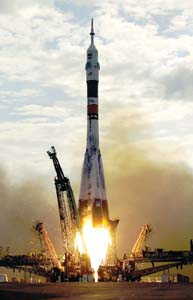 |
A Russian Soyuz spacecraft launches last April from Baikonur Cosmodrome in Kazakhstan. After the final space shuttle mission, US astronauts will have to hitch rides on Russian rockets. ( NASA photo) |
All was not well with America’s civilian space endeavors. While the US military effort was based on careful investment in key technologies and programs that gave to the United States unprecedented abilities to use and exploit space, the civilian space enterprise tended more and more to resemble a top-down, Soviet-style model of governmental-industrial enterprise, obsessed with the next big thing.
The problem was exacerbated by the differing operational philosophy, and differing external expectations, between the old NACA and the NASA that replaced it.
In the interwar years, the National Advisory Committee for Aeronautics (NACA), the predecessor of NASA, pioneered research in aerodynamics, materials and structures, propulsion, and controls, issuing reports and findings that the American aircraft industry turned to military and civil use. Using NACA data—the gold standard of aeronautical research—American and foreign designers alike reshaped the airplane, building new and highly efficient military and civil aircraft.
The NACA of the 1930s, however, did not have to develop airliners and run airlines. In the 1960s and afterward, NASA had to develop spacecraft and run the “spaceline.” It had to develop the database, compete various designs, pick a winner, sponsor development, build it, and then operate it.
The result was a largely corporate socialist enterprise, just the opposite of the free-market-driven aviation industry and the Air Force model of space development. NASA’s space efforts, and to a degree its aeronautical research enterprise as well, was hostage to complex, expensive, difficult-to-maintain programs, particularly the space shuttle and International Space Station, each of which had long and costly development periods.
Management in Schriever’s style, built upon proven launch technology such as Titan and Gemini, envisioned use of smaller spaceplanes. This could have generated a robust, innovative, and steadily evolving ability to operate in space.
What we got, instead, was the space shuttle, a much more complex and challenging system that, for all its great merit, was expensive to operate, unforgiving of error, and in an era of limited resources, a huge consumer of available capital.
Certain NASA and Air Force officials, most of them within the flight test and flight research community, tried to reverse this trend and achieve a more persistent space presence. They met with little to no success. Indeed, so dominant did the shuttle program become that Congress canceled future buys of expendable launch vehicles, a serious error in judgment rectified only after the disastrous Challenger accident of 1986.
Today, there is undeniable evidence that Washington is retracing its steps and is about to commit the same errors, with the likely result of hampering the nation’s civil space effort. It is a mistake that inevitably will affect the robustness of America’s military space effort.
The Obama Administration’s space budget, released in February, ended NASA’s Constellation program, which aimed to return man to the moon. The Administration also truncated development of the Ares next generation launch systems. It chose to focus instead on preparations for a grandiose manned mission to Mars.
In a visit to the Kennedy Space Center on April 15, President Obama forecast a bold future of “the first-ever crewed missions beyond the moon into deep space,” launching crews to asteroids, orbiting Mars, and then, in the “mid-2030s” landing on the “Red Planet” and returning to Earth.
All good stuff—dating to the 1950s and the speculations of von Braun and a myriad of other space enthusiasts.
Robust, Reliable, Ready Astronaut Aldrin supported the go-to-Mars initiative. Other veteran astronauts resoundingly disagreed. Armstrong, James A. Lovell, and Eugene A. Cernan, respectively the mission commanders of Apollo 11, 13, and 17, issued an appeal remarkable for its forthrightness and passion.
In an open letter to the President, the three astronauts urged reconsideration, warning that his cancellations of the more modest programs would waste $10 billion in R&D investment. More worrisome, they said, it would take “many years … to recreate the equivalent of what we will have discarded.”
The astronauts said that, “without carriage to low Earth orbit and with no human exploration capability to go beyond Earth orbit for an indeterminate time into the future,” the US risked becoming a nation of “second- or even third-rate stature,” and that the cuts likely ensured the United States would be “on a long downhill slide to mediocrity,” preventing it from ever fulfilling the President’s desire to reach Mars.
“America,” they concluded, “must decide if it wishes to remain a leader in space.”
Over the last half-century, similarly bold plans have fizzled, to the frustration of space advocates who have witnessed other nations doggedly moving ahead even as the US slows down, approaching retrograde motion. They ask a compelling question: Does the US have a real future in space
Writing in 1980, on the eve of the shuttle era, space historian Walter A. McDougall noted perceptively, “A thumbnail definition of a great power between the two world wars might have been: ‘A nation that builds its own airplanes.’ The updated version would be: ‘A nation that launches its own spacecraft.’ “
For the moment, and thanks largely to the Air Force, the nation continues to possess robust, redundant, reliable, and ready space capabilities, and its space practitioners are rightly focused on practical, necessary, and achievable future systems. It is not realistic, however, to expect the Air Force, in the years ahead, to continuously make up for civilian weakness caused by the lack of a coherent national space strategy.
National space strategy has to incorporate a coherent lasting vision of civil and military space working together to furnish the space power America will continue to need in the 21st century.
Feel-good sound bites evoking images of long-term, gargantuan state programs having at best a dubious chance of ever reaching the hardware stage cannot substitute for rational planning. Dreams of Mars make little sense in a time when key space infrastructure is being closed, thousands are leaving the aerospace field, and American astronauts learn Russian so that they can ride Soyuz into space.
Richard P. Hallion is an aerospace historian who served 11 years as the Air Force historian and has written widely on aerospace technology and airpower topics. His most recent article for Air Force Magazine, “Richard Whitcomb’s Triple Play,” appeared in the February issue.
